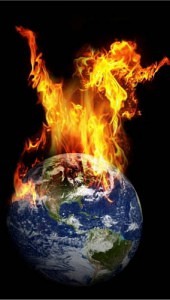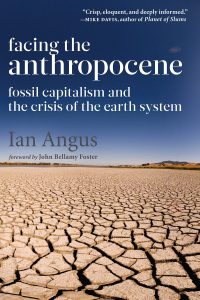Facing the Anthropocene: Fossil Capitalism and the Crisis of the Earth System
280 pp, $19 pbk, ISBN 9781583676097
By Ian Angus
Reviewed by Brent Ryan Bellamy for Science & Society, volume 81, number 3, July 2017
Reprinted with permission
In “Friday’s Child,” an episode of Star Trek, Chief Engineer Scott says: “There’s an old, old saying on Earth, Mister Sulu. Fool me once, shame on you. Fool me twice, shame on me.” Without missing a beat Ensign Chekov replies, smirking, “I know this saying. It was invented in Russia” (NBC, December 1, 1967). If Chekov were to make a similar claim about the Anthropocene, he would be right, even 50 years ago when the episode first aired. In John Bellamy Foster’s rousing foreword to Ian Angus’ Facing the Anthropocene, he notes that the Russian geologist and paleontologist Alexei Petrovich Pavlov (1854–1929) was the first to use the term “Anthropocene” in 1922 (27). When it comes to the infighting on the left over what the term means and the denial by the right that it even exists, Ian Angus’ book makes quite clear that unless the left can focus on developing radical alternatives to fossil capitalism we will only be fooling ourselves.
So, what is the Anthropocene? Angus insists that the Anthropocene does not constitute a cultural moment such as Romanticism or a political–economic one such as the long 20th century; rather, he follows scientific consensus. Paul Crutzen is the scientist credited with naming the new geological era at the meeting of the 2000 International Geosphere–Biosphere Program in Mexico and climate scientist Will Steffen dubbed this moment The Great Acceleration (Steffen apparently sought inspiration in Karl Polyani’s 1944 book The Great Transformation [42]; readers might also be interested in Amitav Ghosh’s new book The Great Derangement: Climate Change and the Unthinkable [2016]). The charts on pages 44 and 45 are perhaps the most convincing visual demonstration of Great Acceleration; readers interested in seeing these, who don’t have a copy of the book, can most likely find them by searching the web for their colloquial title “hockey stick graphs.” These graphs show dramatic spikes in earth system trends (from carbon dioxide to ocean acidification) and socioeconomic trends (from world population to international tourism) occurring circa 1950.
Angus takes on critics of the concept directly by showing that scientists already agree that not all humans are equally responsible. For instance, he writes that by 1950, “the atmospheric concentration of carbon dioxide had risen about 35 parts per million above the preindustrial level, and 65 percent of that was due to emissions generated in just two countries, the United States and the United Kingdom” (152). Though CO2 emissions are only one of the drivers of the epochal shift that has taken place, like other drivers, they are not evenly produced. Other central identifiers of the new geological epoch include nitrogen fixing and the traces of chemical pesticides used in agriculture, the development and spread of plastics, the glow of radionuclides, and even large deposits of chicken bones from industrial animal farms.
The title of Angus’ book has been expertly selected; it explicitly outlines the contents of the book in reverse order. In the first section, Angus explains the origins, meaning, and use of the term “Anthropocene.” Thoroughly researched and clearly communicated, “Part One: A No-Analogue State” works within the domain of climate science. Readers hazy on the meaning and usefulness of the concept of the Anthropocene will find this section incredibly helpful, while readers more familiar with the key players and concepts informing the latest geological age will find it to be an excellent reference. Similarly, “Part Two: Fossil Capitalism” shows how the history of capitalism has also been a history of environmental impacts, from the lofty atmosphere of carbon dioxide and ozone depletion to the deep churn of ocean acidification and plastics. On the one hand, Angus identifies ozone depletion as the first crisis of the Anthropocene (“The First Near Catastrophe,” 78–88). On the other, he cites a report estimating that “there are 150 million tonnes of plastics in the oceans today, and that by 2050 plastics in the oceans will outweigh all fish” (169).
Angus ends the book with a clear elaboration of the first part of his title, “Facing the Anthropocene.” Given the indirect, collective shaping of the world we live in, it is about time to take a stake in consciously deciding the direction of humanity on the planet. In “Part Three: The Alternative” Angus makes a case for an egalitarian, ecologically-mindful solidarity.
Facing the Anthropocene stands out for the way Angus has woven scientific discourse with an account of capital and the fossil fuel regime. After all, if the Anthropocene teaches us one lesson, it is that working together humanity can accomplish incredible things. Karl Marx precisely identified this problem: when the mode of production is geared towards producing value, it strives to do so without foresight of the social and environmental impacts. Angus writes: “Overwhelmingly, the victims [of climate change] are poor and disadvantaged. Globally, 99 percent of weather disaster casualities are in developing countries, and 75 percent of them are women” (176). He proves Marx to be absolutely correct in his assessment of capitalism’s absolute wastefulness with a host of examples and plenty of data.
What makes Facing the Anthropocene a recommendable book is the way Angus tracks the totality of social relations under fossil capitalism. This book is one of the clearest and most decisive I have read on the subject. It is required reading for people trying to understand not only how the Anthropocene arrived on the scene, but why communists, Marxists, socialists, and left-leaning people everywhere ought to understand it and have a say in how we shape our collective destiny. History will make clear if a radically different kind of life in the Anthropocene is indeed possible. If it is not, it will be more than just the burden of shame landing on our collective shoulders.


Comments are closed.